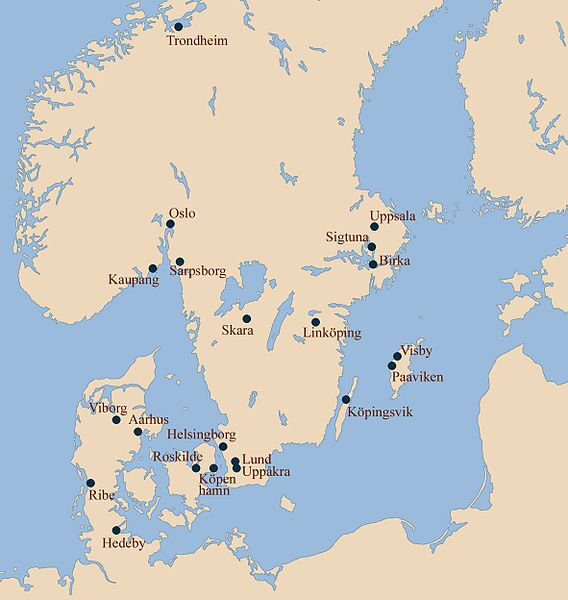Before the Viking Age, there weren’t any real towns in Scandinavia. Instead, the landscape was dotted by small farming or fishing villages where the self-reliant population worked and lived. Nearly everything a Viking family needed, they made themselves. However, they also grew extra crops or raised extra livestock to use in trade for some things they couldn’t make or get from their farms, such as salt or iron tools.
As the Vikings began raiding and trading into Europe and Russia during the 8th and 9th centuries, local kings began to set up trading centers, where international traders could bring their goods. Wily traders, however, don’t bring valuable goods to places that aren’t safe, so the kings had to provide protection. For the use of the land and protection, kings could tax the traders’ goods. The kings found that trading centers added to their economic base and increased their standing as good leaders.
Hedeby, Denmark (now Germany), Birka, Sweden and Kaupang, Norway were all begun in this manner, as a trade center. At first the trade centers were only used in the warm seasons, late spring, summer and early fall. Later, as they began to become actual towns, people lived there year round. Each of these towns was strategically located in easy-to-protect harbors near natural trade routes.
These trade towns attracted the talented craftsmen of Scandinavia: blacksmiths, bronze casters, bead makers, glass-blowers, jewelers, potters, leather-workers, weavers and dyers. Farms outside of the towns produced the food the townspeople ate. A protected, thriving market became a great attraction. Traders from all over came to the market.
Ribe, Denmark was another trade center and Denmark’s earliest town. Hedeby was the larger market, covering far more territory than Ribe. If you wish to learn more about a busy trade town, look at the Ribe Viking Center. There you will find a working manor farm, a town and a market. If you can’t visit, the Web page is handsome and informative.
Archeologists found permanent stone hearths and houses with attached workshops when the trade town sites were excavated. Raw materials came in, and finished products went out. Beads, silver, traces of textiles, cups, molds for brooches and other items were found on the trade sites.
Excavations also revealed silver and gold coins, a sign that Vikings had moved from direct barter trading to using trade using precious metals as a form of currency. Everywhere archeologists found hack silver—bits of silver jewelry cut up to the weight needed to buy something—and the scales traders used to weigh out silver. The trade towns usually hosted a mint for making coins as well. By the 10th century, when most of Scandinavia became Christian, Viking trade towns were integrated into the European marketing network. No longer were Vikings out raiding, but trade continued strong.
This article is part of our larger selection of posts about Vikings history. To learn more, click here for our comprehensive guide to Vikings history
Cite This Article
"Viking Trade Towns" History on the Net© 2000-2024, Salem Media.
April 18, 2024 <https://www.historyonthenet.com/viking-trade-towns>
More Citation Information.
